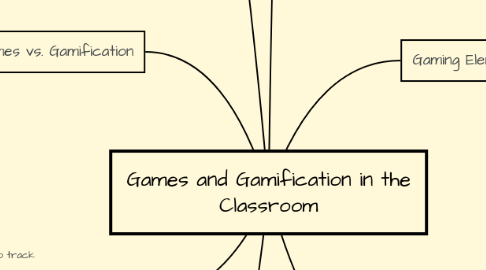
1. Pros
1.1. Provides metrics: Teachers have data/measurements they can use to track student learning and outcomes
1.2. Increases engagement with the content
1.3. Can be highly customizable for implementing teacher: can make is as complex or simple as desired
2. Cons
2.1. Over reliance on or ineffective use of gamification for rewards may decrease intrinsic AND extrinsic motivation
2.2. For more complex use, can be very time consuming and involved; requires consistency and organization
2.3. Depending on the system and technology requirements, can be expensive
3. Games vs. Gamification
3.1. Games
3.1.1. Defined rules and objectives
3.1.2. Possibility of losing; element of finality
3.1.3. Content molded to fit the game
3.1.4. Primarily intrinsic
3.2. Gamification
3.2.1. Can consist of rules and objectives, but also includes collections of tasks, rewards, and points
3.2.2. Losing may or not be possible, as object is the completion of tasks; ongoing system
3.2.3. System is molded to fit the content
3.2.4. Can be intrinsic or extrinsic
4. Sources
4.1. Microsoft in Education. July 31, 2011. Game designer Jane McGonigal interview by Cameron Evans, U.S. Education CTO, Microsoft. [Video file]. Retrieved from https://www.youtube.com/watch?v=5-mc9Rrfs00
4.2. TED. March 17, 2010. Jane McGonigal: Gaming can make a better world. [Video file]. Retrieved from http://www.youtube.com/watch?v=dE1DuBesGYM.
4.2.1. These videos explain the need for the problem solving skills developed by gamification and how gamification helps students in the classroom. In the first video, McGonigal explains the unique assessment qualities that gamification can provide students. In the second, she speaks about the need for the unique problem solving skills and other "superpowers" that gamification can provide to students. The various links explain the basics of gamification, the difference between gamification and games, the pros and cons of gamification, and how teachers can gamify their own classrooms.
4.3. Admin. Sept. 28, 2011. The Gamified Classroom. [Web log post]. Retrieved from http://www.gamification.co/2011/09/28/the-gamified-classroom/.
4.4. Gamification of Education. n.d. Gamification Wiki. Retrieved from https://badgeville.com/wiki/education.
4.5. Zalno, J. The Pros and Cons of Gamification in the Classroom. July 22, 2013. Retrieved from http://www.edtechmagazine.com/higher/article/2013/07/pros-and-cons-gamification-classroom.
4.6. Suzanne. 4 Ways to Bring Gamification of Education to Your Classroom. [Web log post]. Retrieved from http://blog.tophat.com/4-ways-to-gamify-learning-in-your-classroom/.
4.7. Venables, M. Ben Bertoli's ClassRealm is Gamifying the Classroom. May 7, 2012. Wired. Retrieved from http://www.wired.com/2012/05/ben-bertolis-classrealm/.
5. Adding gaming elements to non-gaming activities to increase engagement. Especially attractive for technology usage in the classroom. Can be used in the following ways:
5.1. Incentives, motivation, and rewards
5.2. Refocusing attention
5.3. Reinforce and review learned material
5.4. Problem solving skills
5.5. Behavior and classroom management
6. Gaming Elements
6.1. Simple
6.1.1. Instructor led
6.1.1.1. PowerPoint game templates used for whole class
6.1.1.1.1. Who Wants to Be a Millionare
6.1.1.1.2. Jeopardy
6.1.2. Computer based
6.1.2.1. Online learning games
6.1.2.1.1. Knowledge Adventure (Pre K- 6)
6.1.2.1.2. Learn 4 Good (K - 12)
6.1.2.1.3. Fun Brain (K - 8)
6.1.2.2. Web Quests/Virtual Scavenger Hunts
6.2. Complex
6.2.1. Instructor led
6.2.1.1. Rewards and points assigned to tasks (System)
6.2.1.2. Defining "levels" for student progress on different tasks and assignments: extensions; Bloom's Taxonomy
6.2.2. Computer based
6.2.2.1. Online badges and achievements (System)
6.2.2.2. Whole Class Gamification
